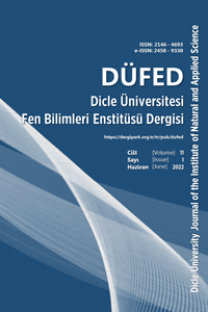Farklı pamuk çeşitlerinde anter kültürü tekniğiyle kallustan embriyoid elde edilmesi
Bu çalışmanın amacı, anter kültürü için pamukta en iyi embriyoidleri veren kallusların elde edilmesi için, en iyi besi ortamının seçilmesi ve en fazla kallus oluşumunu teşvik edecek bitki Büyüme Düzenleyicilerinin saptanmasıdır.Üç farklı pamuk çeşidi olan Aşkabat-100 Gossypium barbadense L. , Coker-312 ve Stoneville-468 Gossypium hirsutum L. ’den alınan taraklar kallus indüksüyonu için çalışılmıştır. Çalışmada farklı boylardaki olgunlaşmamış çiçek tomurcuklarından alınan pamuk anterleri kullanılmıştır. Aseptik koşullarda anterler yüzey sterilizasyonuna tabi tutulduktan sonra kallus indüksiyonu için bitki büyüme düzenleyicisi içeren besi ortamlarına aktarılmıştır. Aşkabat-100 çeşidinde farklı uzunluktaki anterlerde en yüksek oranda embriyoidleri veren kallus, 2 mm uzunlukta 97.00 , Stoneville-468 çeşidinde en yüksek embriyoidleri veren kallus, 5 mm uzunlukta 72.63 , Coker-312 çeşidindeki anterlerde en yüksek embriyoidleri veren kallus oluşumu 3 mm anter uzunluğunda 55.80 , başlatılan kültürler ve alt kültürlerde saptanmıştır. Araştırma sonucunda, Aşkabat-100 çeşidi kallus, embriyoidleri veren kallus ve embriyoid oluşumu için en uygun sonuçları vermiştir. Daha sonra embriyoidlere dönüşen embriyoid kalluslar için en iyi değerler, hormonsuz 80.00 ve 0.1-0.5 mg/l kinetin ilaveli 66.00-61.60 ve 2.0 mg/l 2,4-D ilaveli 92.00 , MS besi ortamlarında görülmüş ve ölçülmüştür. En yüksek embriyoid veren kallus ve embriyoid oluşumu alt kültürlerde 85.60 0.5 mg/l kinetin içeren besi ortamında gerçekleşmiştir
Embriyoid formation from anther culture derived calluses in different cotton cultivars
Cotton is one of the products that has an important place in agricultural, industrial and trade sectors in the world with its diverse areas of use. The aim of the study is to obtain calluses that produce the best embryoids in cotton from anther culture, choosing the best nutrient media and finding the Plant Growth Regulators that produce the highest callus formation. In this study, using different anther sizes 2, 3, 4, 5 mm obtained from cotton plant square, calluses that might provide MS Muroshige and Skoog embryoids will be obtained. The square taken from three different types of cotton, Aşkabat-100 Gossypium barbadense L. , Coker-312 ve Stoneville-468 Gossypium hirsutum L. are studied for callus induction. In the study, cotton anthers taken from different length immature flower buds square are used. After anthers were subjected to surface sterilization in aseptic conditions, the anthers were isolated and then transferred to nutrient media containing plant growth regulators for callus induction. In Aşkabat-100 cultivar among the different length anthers, 2 mm 97.00 callus produced the highest percentage of embryoids, 5 mm 72.63 of callus resulted in the highest embryoid formation in the Stoneville cultivar and, 3 mm callus size in cv Coker-312 gave the thighest embryoid formation 55,80 . As a result of the study, the Aşkabat-100 cultivar callus produced the best results for embryoid producing calli and embyroid formation. After that, the best results for embryoid calli that turn into embyroids were seen and measured at medium containing no-hormone 80.00 and 0.1-0.5 mg/l kinetin supplemented 66.00-61.60 ve 2.0 mg/l 2,4-D supplemented 92.00 MS nutrient media. The embryoid formation and callus that produces the most embryoid formation were realized in feeding media in subcultures containing 85.60 0.5 mg/l kinetin
___
- [1] Anonim. 2015. https://www.icac.org/getattachment/HomeInternational-Cotton-Advisory-CommitteeICAC/measuring-sustainability-cotton-farming-fullenglish.pdf
- [2] Atanassov, A., Zagorska, N., Boyadjiev, P., Djilianov, D., 1995. In vitro production of haploid plants, World J, Microbiol Biotechnol. 11: 400–408.
- [3] Christidis, B.G. and Harrison, G.F. 1955. Cotton Growing Problems. McGraw-Hill, New York
- [4] Davidonis, G.H., Hamilton R.H., 1983. Plant regeneration from callus tissue of (Gossypium hirsutum L.) Plant Science Letter, 32: 89-93
- [5] Forster, B.P., Heberle-Bors, E., Kasha, K.J., Touraev, A., 2007. The resurgence of haploids in higher plants. Trends in plant science, 12(8), 368-375.
- [6] Gencer, O., Özüdoğru, T., Kaynak, M.A., Yılmaz, A., Ören, M. N. 2004. Türkiye’de Pamuk üretimi ve sorunları. www.zmo.org.tr/etkinlikler/6tk05/022oktaygencer.pdf
- [7] Hatipoğlu, R., 2002. Bitki Biyoteknolojisi. Ç.Ü. Ziraat Fakültesi Genel Yayın No: 190, Ders Kitapları Yayın No: A-58, Ç.Ü. Yayınları No: 47, Adana.
- [8] Liang, G.H., Xu, A., Tang, H., 1987. Direct generation of wheat haploids via anther culture.Crop Sci 27: 336– 339.
- [9] Maluszynski, M,. Kasha, K.J., Forster, B.P., Szarejko, I. (eds). 2003. Doubled haploid production in crop plants: A manual. Kluwer. Dordrecht.
- [10] Murashige, T., Skoog, F., 1962. A revised medium for rapid growth and bioassays with tobacco tissue cultures. Physiol. Plantarum 15: 473–497.
- [11] Reinert J., Bajaj, Y.P.S., Heberle, E., 1977 a. Factors enhancing in vitro production of haploidplants in anther and isolated microspore cultures. In: Gautheret, R., (eds). La culture des tissue et des cellules des ve´ge´taux. Mason. Paris. 47–58.
- [12] Shariatpanahi, M.E., Bal, U., Heberle-Bors, E., Touraev, A., 2006. Stresses applied for the reprogramming of plant microspores towards in vitro embryogenesis. Physiologia Plant 127:519–534.
- [13] Sharma, A.K., Sharma, A. 1972. Chromosome techniques. Butterworths/University Park Press, London/Baltimore.
- [14] Vasil, I.K., 1980. Androgenic haploids. Int. Rev. Cytol. Suppl. 11A: 19
- ISSN: 2146-4693
- Yayın Aralığı: Yılda 2 Sayı
- Başlangıç: 2012
- Yayıncı: Dicle Üniversitesi
